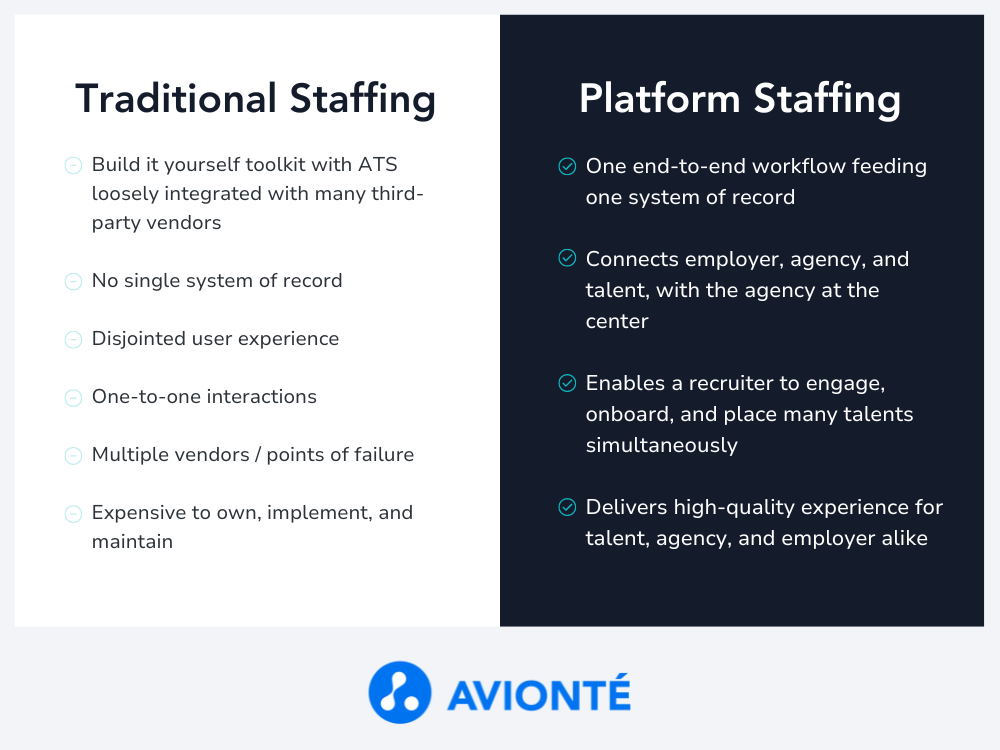
Embracing Tech-Driven Strategies to Source Candidates and Retain Talent
What measures can staffing agencies use to source job candidates and retain talent, paving the way for continued growth and success?
A major technology shift is underway within the staffing industry—the rapid adoption of mobile-enabled Platform Staffing. While early “talent platforms” earned a poor reputation for quality and service, newer technology and service delivery models are rapidly maturing. Platform staffing will allow agencies who are early adopters to build a competitive edge by leveraging technology, while rendering traditional ATS staffing software obsolete.

To be clear, platform technologies now predominate in many industries, from travel and banking to retail and Gig work. While each application differs, all platforms share common traits. They support end-to-end workflows and a single system of record. They leverage state-of-the art technologies such as artificial intelligence, mobile apps, self-service tools, and automation to deliver a superior customer experience with less time and effort. Most importantly, well-designed platforms permit the capacity to deliver at massive scale. And scalability is exactly what the Staffing Industry needs.
Consider the statistics: the dynamic workforce market—comprising contingent, contract, gig, and temporary roles—is now valued at an astounding $5.3 trillion globally, with $1.8 trillion in the United States alone—and now encompasses 22% of the global workforce. But staffing agencies have not benefited from this explosive growth. The staffing industry, projected to grow only 4% in 2024, has tracked at roughly 2% of the total U.S. employment for almost three decades.
Now consider how much larger the staffing industry could become if we used platform staffing to deliver twice as many candidates in half the time. Imagine an industry where recruiters could routinely handle 30-50 active assignments daily without breaking a sweat. Platform staffing has the potential to give staffing agencies a competitive edge that delivers meaningful value to clients.
Despite the critical need for platform technology in the staffing industry, early iterations of talent platforms failed—sometimes spectacularly. Their biggest issue? Vendors tried to bypass staffing agencies rather than working with them, analogous to the way Uber had displaced cab companies and taxi drivers. By treating staffing as a monolithic use case, they also failed to recognize the unique value that agencies bring to employers. As a result, the first talent platforms over-promised and under-delivered. They alienated the staffing community without addressing the quality and service requirements unique to individual employers. Moreover, they failed to address the employers’ preference to outsource contingent employment to a third party.
So how can the staffing industry harness the transformative potential and scalability of platform staffing while preserving the quality, compliance, and value of traditional staffing? The answer lies in striking a balance that combines the best aspects of traditional and platform staffing operations. Don’t replace the staffing agency or the recruiter. Instead, reimagine them. Platform staffing is about designing technology that enables recruiters and agencies to do what they do today, only better, faster, and at scale. By leveraging advanced technology and empowering recruiters with sophisticated tools, staffing firms can manage high-volume staffing with unparalleled precision and speed. And by fostering collaboration between agencies, employers, and talent, the right staffing platform creates a cohesive ecosystem where all stakeholders can thrive.
For contingent and temporary workforce hiring and management, staffing agencies have long depended on traditional Applicant Tracking Systems (ATS) to manage talent. However, as the industry evolves, a new staffing model has emerged: Platform Staffing. While an ATS focuses primarily on managing the recruitment process—automating tasks like job posting, resume parsing, and interview scheduling—Platform Staffing solutions cast a wider net. They are designed to support the end-to-end staffing process for staffing agencies or recruitment firms.
Below are a few key factors and differences between both systems:

Platform Staffing offers a streamlined approach that integrates key components to enhance the recruitment process. This includes an end-to-end, front- and back-office ATS platform seamlessly integrated with a branded talent mobile app to help support the entire candidate workflow, along with staffing-friendly employer VMS (Vendor Management System) which eliminates dual data entry and automates many common employer service requests, delivering increased speed and better service to large customers.
Thus, some of the key benefits of Platform Staffing include:
Automation sets platform staffing solutions apart from traditional ATS systems by empowering recruiters to streamline repetitive tasks like resume screening, candidate matching, and interview scheduling. By seamlessly integrating platform staffing technology into their workflows, recruiters can significantly boost their efficiency and effectiveness, placing more talent per recruiter in less time, freeing them up to focus on important activities like building client relationships and supporting candidates. As a result, recruiters can increase placements while reducing manual effort and operational costs. With automation, recruiters can recruit more efficiently, saving time and resources.
And unlike gig platforms, which often rely on a large pool of independent contractors with varying levels of experience, staffing firms can provide highly qualified candidates curated through rigorous screening processes. This focus on quality over quantity allows staffing firms to deliver better talent to clients in less time, giving them a competitive edge in the marketplace.
Staffing firms already have skilled recruiters and account managers who understand the nuances of their client’s industries and workforce needs. With advanced search capabilities and AI-driven algorithms, recruiters can swiftly identify ideal candidates, while account managers can use data analytics and reporting tools to provide clients with actionable insights and strategic workforce planning recommendations.
This synergy of human expertise and technological innovation allows staffing agencies to leverage automation effectively, exponentially increasing placement speed and efficiency while optimizing the talent placement process. This combination allows staffing firms to deliver tailored solutions, meeting the unique needs of each client and setting them apart from gig platforms that often offer a one-size-fits-all approach.

One of the standout features of platform staffing is the ability to facilitate seamless communication and collaboration between recruiters, employers, and talent. Through intuitive interfaces and integrated communication channels, recruiters can efficiently engage with candidates, manage job postings, and schedule interviews, all within the same platform.
This seamless workflow not only enhances productivity but also improves the client and candidate experience, fostering stronger relationships and increasing the likelihood of successful placements.

The centralized nature of platform staffing solutions facilitates seamless collaboration among recruiters, employers, and talent. Recruiters can efficiently manage job postings, candidate profiles, and client interactions within the same platform, promoting transparency and accountability throughout the recruitment process. And staffing firms can leverage platform technology to deliver better work outcomes for clients. By optimizing talent acquisition and management processes, firms can reduce time-to-fill rates, improve retention rates, and increase workforce agility. Additionally, employers benefit from real-time access to recruitment updates and candidate progress, enabling informed decision-making and proactive engagement with the hiring process.
Similarly, recruiters can prioritize the employment experience of placed talent by offering a streamlined and transparent candidate experience. Through self-service tools, real-time communication channels, and personalized support, talent receives ongoing assistance throughout their employment journey, enhancing satisfaction and retention. Talent can access job opportunities, send applications, submit all necessary onboarding information, and communicate with recruiters through a user-friendly interface, fostering a positive candidate experience and increasing engagement.
Ultimately, the centralized hub provided by platform staffing models enhances collaboration, communication, and efficiency, driving better outcomes for all stakeholders involved in the staffing process.

Platform staffing solutions revolutionize data management by providing a single, centralized hub for all staffing activities. Unlike traditional ATS systems, which often necessitate integration with multiple disparate tools, platform staffing offers a comprehensive approach, consolidating all data into one accessible location. This singular source of truth enables staffing agencies to efficiently manage candidate profiles, job postings, client interactions, and more, fostering data consistency and integrity across the board.
This centralized hub not only simplifies data management but also enhances strategic decision-making capabilities. With all pertinent information readily available within the platform, recruiters and account managers can gain comprehensive insights into their clients’ industries, workforce needs, and recruitment pipelines. This visibility empowers staffing agencies to identify trends, anticipate challenges, and capitalize on opportunities, driving better strategic results.
The future of workforce management lies in embracing innovation while staying true to the core principles of quality and collaboration, with recruiters at the forefront. By harnessing the power of the right staffing platform, organizations can confidently navigate the complexities of the modern labor market, unlocking unprecedented opportunities for growth and financial success.
While traditional applicant tracking systems have been fundamental to staffing operations, platform staffing solutions elevate the standard with their enhanced functionality, efficiency, and user experience. Embracing this new concept of platform staffing enables agencies to tap into a wealth of advantages, including centralized data management, seamless workflows, productivity gains driven by automation, and heightened stakeholder satisfaction. In today’s fiercely competitive landscape, investing in the right platform technology is crucial for maintaining a competitive edge and achieving exceptional financial outcomes.
With platform staffing solutions, staffing firms can leverage the expertise of their recruiters alongside the efficiency of gig platforms, resulting in an exponential increase in talent placements and revenue generation. This fusion of human insight and technological innovation not only enhances the candidate experience but also leads to greater employee and client satisfaction, ultimately translating into a higher ROI and financial growth for the agencies that effectively leverage them.
Want to see how a modern staffing platform can transform your staffing business and give you an edge above the competition? Schedule a free consultation call today.